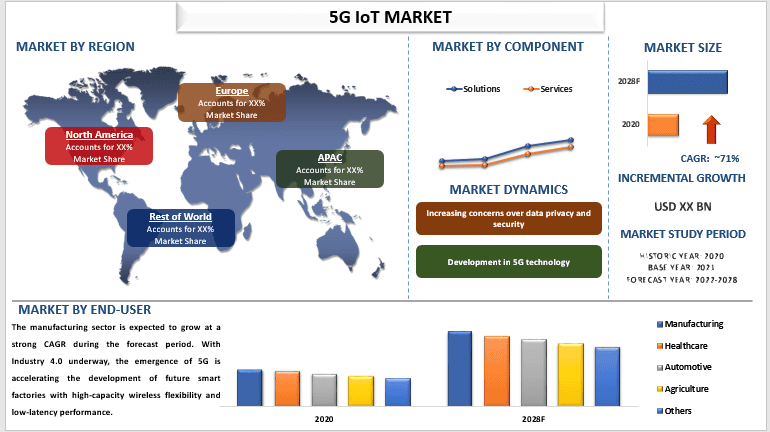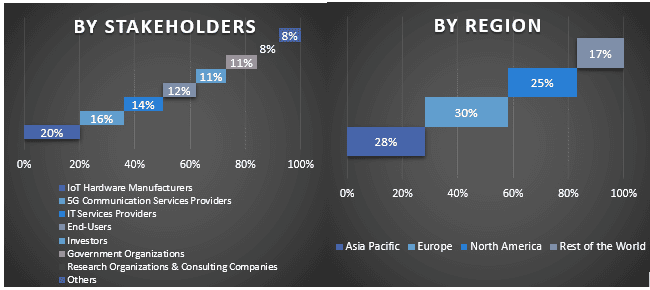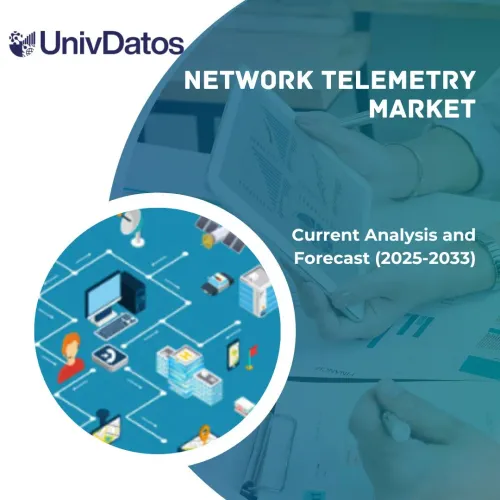- Accueil
- À propos de nous
- Industrie
- Services
- Lecture
- Contactez-nous
Marché de l'IdO 5G : Analyse actuelle et prévisions (2022-2028)
Accent mis sur les composants (Solutions [Matériel et Logiciel] et Services) ; Type de réseau (5G autonome et 5G non autonome) ; Utilisateur final (Fabrication, Santé, Automobile, Agriculture et Autres) ; et Région/Pays

DEMANDER UN EXEMPLE DE PDF GRATUIT
Le marché de l'IoT 5G devrait croître à un fort TCAC d'environ 71 % en raison de la demande croissante de nouveaux cas d'utilisation émergents tels que les villes intelligentes, la télémédecine, l'automatisation industrielle, etc. La technologie de transmission joue un rôle important dans la technologie de l'Internet des objets (IoT). Elle rend automatiquement la nouvelle technologie de communication 5G intégrale à son IoT. La 5G prend en charge une efficacité accrue dans un certain nombre d'applications IoT, y compris les applications liées à la télématique, les applications de télémétrie, l'automatisation des réseaux intelligents, la surveillance à distance, la gestion intelligente du trafic, les applications de fabrication, les applications médicales, l'agriculture intelligente, les villes intelligentes et les maisons intelligentes, et autres. De plus, une diminution de la latence, une densité de connexion élevée, une grande efficacité du spectre et une capacité de trafic jusqu'à 100 fois supérieure sont quelques-unes des caractéristiques les plus importantes qui influencent l'adoption de la 5G dans l'IoT. L'investissement croissant dans les villes intelligentes contribue également à la croissance du marché de l'IoT 5G. Par exemple, selon le SmartAmerica Challenge, les gouvernements locaux investiront 41 billions de dollars US au cours des deux prochaines décennies pour préparer l'infrastructure à l'Internet des objets.
Certains des principaux acteurs opérant sur le marché comprennent AT&T, Verizon, Deutsche Telekom AG, Vodafone Group, Orange, Telefónica S.A., SAMSUNG ELECTRONICS CO. LTD., Telefonaktiebolaget LM Ericsson, Huawei Technologies Co. Ltd. et Cisco Systems Inc. Plusieurs fusions et acquisitions ainsi que des partenariats ont été entrepris par ces acteurs pour fournir aux clients des produits/technologies de haute technologie et innovants.
Aperçus présentés dans le rapport
« Parmi les composants, le segment du matériel détenait une part importante du marché en 2020 »
Selon le composant, le marché est segmenté en solutions et services. Le segment des solutions est divisé en matériel et logiciels. Le segment des solutions a représenté une part importante du marché en 2020. Cette part importante est due à la demande croissante de modules de périphériques IoT dans de nombreux secteurs et verticales, y compris la fabrication, l'énergie et les services publics, le transport et la logistique, et les villes intelligentes. Le matériel utilisé dans les systèmes IoT 5G comprend des périphériques pour les tableaux de bord à distance, des périphériques pour le contrôle, des serveurs, des périphériques de routage ou de pontage et des capteurs. Ces périphériques gèrent des tâches et des fonctions essentielles telles que l'activation du système, la spécification des actions, la sécurité, les communications et la détection pour prendre en charge des objectifs et des actions spécifiques.
« Parmi les types de réseau, le segment autonome 5G détenait une part importante du marché en 2020 »
Par type de réseau, le marché est divisé en 5G autonome et 5G non autonome. Parmi ces deux types, le type autonome 5G représentait une part importante du marché mondial de l'IoT 5G en 2020 et devrait croître à un TCAC important, principalement en raison de certaines capacités intégrées telles que le découpage de réseau, la très faible latence, la séparation du panneau de contrôle et d'utilisateur (CUPS), la prise en charge multi-Gbps, la virtualisation, etc. Le type de réseau autonome 5G est un tout nouveau réseau sans fil pour les réseaux 5G. Il comprend principalement un réseau d'accès radio 5G (RAN) et un réseau central 5G. Ce type de réseau devrait être plus efficace que le type de réseau 5G non autonome.
« L'Asie-Pacifique devrait croître à un fort TCAC au cours de la période de prévision »
Le marché de l'IoT 5G en Asie-Pacifique devrait croître à un TCAC important au cours de la période de prévision. La région évolue de manière dynamique en termes d'introduction de nouvelles technologies dans divers domaines. La croissance de l'infrastructure et le déploiement accru des réseaux 4G et 5G dans la région APAC, en particulier au Japon, en Corée du Sud, à Singapour, en Inde et en Chine, offrent de grandes opportunités pour la mise en œuvre des services IoT 5G. Par exemple, selon GSMA Intelligence, la Chine comptait 480 millions de connexions 5G à la fin de 2021, qui devraient atteindre 650 millions en seulement un an, représentant plus de 60 % des connexions mobiles 5G mondiales.
Raisons d'acheter ce rapport :
- L'étude comprend une analyse de la taille du marché et des prévisions validée par des experts clés authentifiés du secteur.
- Le rapport présente un aperçu rapide des performances globales du secteur en un coup d'œil.
- Le rapport couvre une analyse approfondie des principaux pairs du secteur, en mettant l'accent sur les principaux aspects financiers de l'entreprise, les portefeuilles de produits, les stratégies d'expansion et les développements récents.
- Examen détaillé des moteurs, des contraintes, des tendances clés et des opportunités qui prévalent dans le secteur.
- L'étude couvre de manière exhaustive le marché à travers différents segments.
- Analyse approfondie au niveau régional de l'industrie.
Options de personnalisation :
Le marché mondial de l'IoT 5G peut être davantage personnalisé en fonction des exigences ou de tout autre segment de marché. En outre, UMI comprend que vous pouvez avoir vos propres besoins commerciaux, n'hésitez donc pas à nous contacter pour obtenir un rapport qui correspond parfaitement à vos besoins.
Table des matières
Méthodologie de recherche pour l'analyse du marché de l'IoT 5G (2022-2028)
L'analyse du marché historique, l'estimation du marché actuel et la prévision du marché futur du marché mondial de l'IoT 5G ont été les trois principales étapes entreprises pour créer et analyser l'adoption de l'IoT 5G dans les principales régions du monde. Une recherche secondaire exhaustive a été menée pour collecter les chiffres du marché historique et estimer la taille actuelle du marché. Deuxièmement, pour valider ces informations, de nombreuses conclusions et hypothèses ont été prises en considération. De plus, des entretiens primaires exhaustifs ont également été menés avec des experts de l'industrie à travers la chaîne de valeur du marché mondial de l'IoT 5G. Après l'hypothèse et la validation des chiffres du marché par le biais d'entretiens primaires, nous avons utilisé une approche descendante/ascendante pour prévoir la taille complète du marché. Par la suite, des méthodes de ventilation du marché et de triangulation des données ont été adoptées pour estimer et analyser la taille du marché des segments et sous-segments de l'industrie concernée. La méthodologie détaillée est expliquée ci-dessous :
DEMANDER UN EXEMPLE DE PDF GRATUIT
Analyse de la taille du marché historique
Étape 1 : Étude approfondie des sources secondaires :
Une étude secondaire détaillée a été menée pour obtenir la taille du marché historique du marché de l'IoT 5G à partir de sources internes à l'entreprise telles que les rapports annuels et les états financiers, les présentations de performances, les communiqués de presse, etc., et de sources externes, notamment les revues, les actualités et les articles, les publications gouvernementales, les publications des concurrents, les rapports sectoriels, les bases de données tierces et d'autres publications crédibles.
Étape 2 : Segmentation du marché :
Après avoir obtenu la taille du marché historique du marché de l'IoT 5G, nous avons mené une analyse secondaire détaillée pour recueillir des informations sur le marché historique et les parts des différents segments et sous-segments pour les principales régions. Les principaux segments inclus dans le rapport sont les composants, le type de réseau et l'utilisateur final. Des analyses plus approfondies au niveau des pays ont été menées pour évaluer l'adoption globale de l'IoT 5G dans cette région.
Étape 3 : Analyse des facteurs :
Après avoir acquis la taille du marché historique des différents segments et sous-segments, nous avons mené une analyse des facteurs détaillée pour estimer la taille actuelle du marché de l'IoT 5G. De plus, nous avons mené une analyse des facteurs à l'aide de variables dépendantes et indépendantes telles que les composants, le type de réseau et l'utilisateur final du marché de l'IoT 5G. Une analyse approfondie a été menée pour les scénarios de demande et d'offre en tenant compte des principaux partenariats, fusions et acquisitions, de l'expansion des activités et des lancements de produits dans le secteur du marché de l'IoT 5G à travers le monde.
Estimation et prévision de la taille actuelle du marché
Dimensionnement actuel du marché : sur la base des informations exploitables tirées des 3 étapes ci-dessus, nous sommes arrivés à la taille actuelle du marché, aux principaux acteurs du marché mondial de l'IoT 5G et aux parts de marché des segments. Tous les pourcentages de parts requis et les répartitions du marché ont été déterminés à l'aide de l'approche secondaire mentionnée ci-dessus et ont été vérifiés par le biais d'entretiens primaires.
Estimation et prévision : pour l'estimation et la prévision du marché, des pondérations ont été attribuées à différents facteurs, notamment les moteurs et les tendances, les contraintes et les opportunités disponibles pour les parties prenantes. Après avoir analysé ces facteurs, les techniques de prévision pertinentes, c'est-à-dire l'approche descendante/ascendante, ont été appliquées pour parvenir à la prévision du marché pour 2028 pour différents segments et sous-segments sur les principaux marchés mondiaux. La méthodologie de recherche adoptée pour estimer la taille du marché comprend :
- La taille du marché de l'industrie, en termes de revenus (USD) et le taux d'adoption du marché de l'IoT 5G sur les principaux marchés nationaux
- Tous les pourcentages de parts, les répartitions et les ventilations des segments et sous-segments du marché
- Les principaux acteurs du marché mondial de l'IoT 5G en termes de produits proposés. De plus, les stratégies de croissance adoptées par ces acteurs pour concurrencer sur le marché en croissance rapide
Validation de la taille et de la part du marché
Recherche primaire : des entretiens approfondis ont été menés avec les principaux leaders d'opinion, notamment les cadres supérieurs (CXO/VP, chef des ventes, chef du marketing, chef des opérations, chef régional, chef de pays, etc.) dans les principales régions. Les conclusions de la recherche primaire ont ensuite été résumées et une analyse statistique a été effectuée pour prouver l'hypothèse énoncée. Les contributions de la recherche primaire ont été consolidées avec les conclusions secondaires, transformant ainsi l'information en informations exploitables.
Répartition des participants primaires dans différentes régions

Ingénierie du marché
La technique de triangulation des données a été utilisée pour compléter l'estimation globale du marché et pour parvenir à des chiffres statistiques précis pour chaque segment et sous-segment du marché mondial de l'IoT 5G. Les données ont été divisées en plusieurs segments et sous-segments après avoir étudié divers paramètres et tendances dans les domaines des composants, du type de réseau et de l'utilisateur final sur le marché mondial de l'IoT 5G.
L'objectif principal de l'étude mondiale du marché de l'IoT 5G
Les tendances actuelles et futures du marché mondial de l'IoT 5G ont été mises en évidence dans l'étude. Les investisseurs peuvent obtenir des informations stratégiques pour fonder leur discrétion en matière d'investissements sur l'analyse qualitative et quantitative effectuée dans l'étude. Les tendances actuelles et futures du marché ont déterminé l'attractivité globale du marché au niveau régional, offrant une plate-forme aux participants industriels pour exploiter le marché inexploité afin de bénéficier d'un avantage de premier arrivé. Les autres objectifs quantitatifs des études comprennent :
- Analyser la taille actuelle et prévue du marché de l'IoT 5G en termes de valeur (USD). Analyser également la taille actuelle et prévue du marché des différents segments et sous-segments
- Les segments de l'étude comprennent les domaines des composants, du type de réseau et de l'utilisateur final
- Définir et analyser le cadre réglementaire de l'industrie de l'IoT 5G
- Analyser la chaîne de valeur impliquée avec la présence de divers intermédiaires, ainsi qu'analyser les comportements des clients et des concurrents de l'industrie
- Analyser la taille actuelle et prévue du marché de l'IoT 5G pour la région principale
- Les principaux pays des régions étudiées dans le rapport comprennent l'Asie-Pacifique, l'Europe, l'Amérique du Nord et le reste du monde
- Profils d'entreprise du marché de l'IoT 5G et stratégies de croissance adoptées par les acteurs du marché pour se maintenir sur le marché en croissance rapide
- Analyse approfondie au niveau régional de l'industrie
Connexes Rapports
Les clients qui ont acheté cet article ont également acheté










